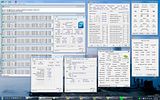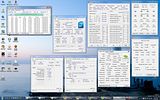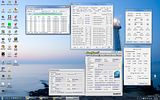I guess I'm safe to brag every now and then. Rob asked me if this overclock was stable... well, lets see. There's actually a pretty lengthy story for this build, it took much longer than it should have before I could even get it started, but I won't get into that here. I assume pics will be wanted... I'll have to take some, sorry! 
After spending a full day gutting, tearing down, cleaning out, and eventually rebuilding not just this system but my trusty Q6600 platform into a HAF 932 case (my now backup system) I was quite eager to sit down and have some fun, not to mention have a computer to use again! The case and a few parts were resused, the entire watercooling loop stripped down, cleaned, and rebuilt with some improvements and new tubing. I did run into some problems mounting the Apogee GTZ waterblock, if I had known in advance I would have gone with the D-Tek Fuzion. My build would have died on the spot if I hadn't also just happened to ahve bought a Thermalright LGA1366 mounting kit, which fixed the three main problems I ran into with the Apogee GTZ. Again, I simply recommend users go the D-Tek route on this one as I am less than impressed with the GTZ's mounting design. If I could've gotten my money back I would have waited the required time for the D-Tek unit to arrive before even completing the build, it was just that bad of a mounting design flaw.
To avoid the Intel RAID nightmares I used just a single 750GB Seagate drive. I'm done with RAID, and in the future the next system upgrade will be to an SSD (Intel is releasing 34nm flash SSD's around the time Windows 7 will go gold, very convenient)... the complete ease of use and lack of problems only tells me I made the right choice forgoing RAID this time around.
I built this rig just after Windows 7 Beta went live, so after firing up the system and installing Windows 7 Beta 64bit, I manually set the correct stock RAM timings in the BIOS, rebooted to Windows, and gave IntelBurn a quick run:
Here's IntelBurn.
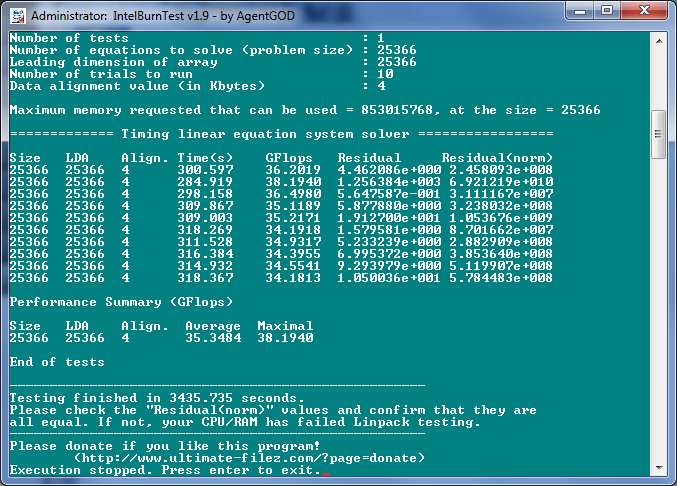
Notice anything odd? Hmm, wait a minute... I haven't even overclocked yet but the system isn't stable!? At this point I got a sinking feeling about my untested computer build, that dreaded feeling that almost anything could be wrong and I might never find the cause. Oh, did I mention this EX58-UD5 motherboard was a $200 Open Box buy, and way past the return date?
Not to keep in suspense this one I'll chock up to a bit of luck and a keen eye... I remembered distinctly that Gigabyte BIOS's only allow vdimm settings of 1.64v or 1.66v... not the 1.65v called for by the RAM. So playing it safe I had used 1.64v, I mean how could 0.01v be the absolute difference between stability and instability with 6GB of RAM? On a hunch I changed the setting to 1.66v it, and suddenly there were no more errors. Hmm, lesson learned...
Hmm, lesson learned...
Now with that out of the way and a backup system to use it didn't take me long to lose my good manners and decide to overclock the new system before it'd even been breathing for a full day. Not in any particular order, most of my tests were conducted with LinX as IntelBurn is only able to test four of the eight threads. These are my more recent screenshots, as I think all of them were Windows 7 RC:
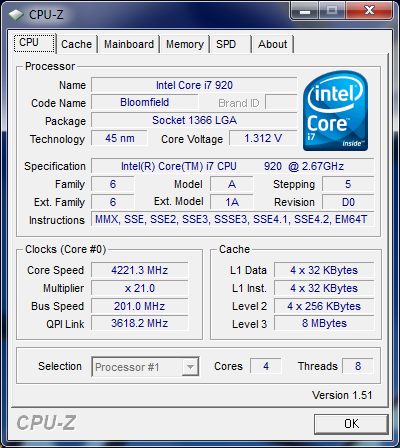
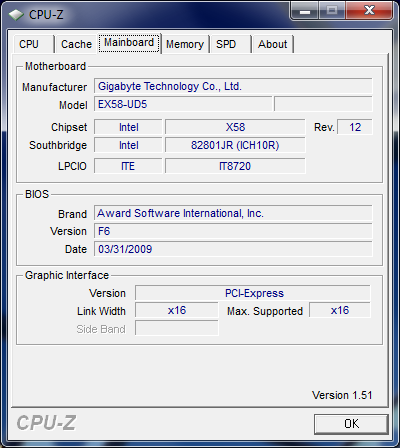
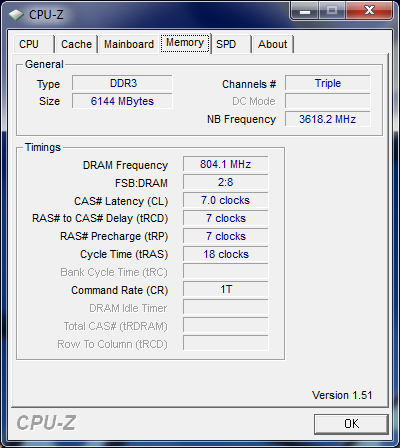
24 Hours Prime stable, check
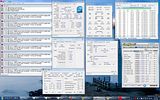
20 4GB runs of LinX under the new RC build of Windows 7, check

Six loops of 3DMark Vantage with all settings maxed out, check
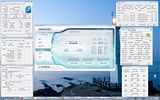
Several lengthy gaming sessions with good friends on Left 4 Dead with settings all maxed out lasting a few hours, double-check
(Sorry, no screenshots )
)
Two full loops of Memtest86+ 2.11v, check
(No photographs either)
Oh, I did say 5GB problem sizes of LinX are much more effective for finding instability, so here's a >5GB problem size of Linx. Each run took over three minutes, 20 runs over an hour. I have done a final 25 run test using a slightly higher problem size that required almost two hours, but I didn't screenshot that for some reason. Because paging the entire 6GB of RAM will make the system laggy a sin I haven't bothered to do it again for a proper screen, but I probably should since I've tightened the RAM timings a bit further yet again...
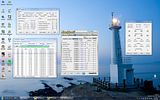
After reading about how Windows 7 changed the system performance scoring, I had to give it a whirl:
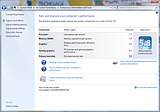
5.9 is the highest a mechanical hard drive can score as I remember, only SSD's have the ability to score to 7.9 depending on how well they do in stuttering and other write/read tests. Believe it or not a GTX 260 didn't even get a 7, and a 4.2GHz Core i7 920 could not even get a 7.9... simply wow! I wonder what kind of system requires a 7.9 processor score... dual-socket Nehalem? After I tuned my RAM timings further, my RAM score finally did reach the maximum score possible of 7.9 shown in the screenshot.
After I tuned my RAM timings further, my RAM score finally did reach the maximum score possible of 7.9 shown in the screenshot.
And for those with a keen eye, or those still reading this far, here's another juicy tidbit for Core i7 overclockers they'll need to know. I could do all of the above using a Vcore of 1.362v, with LoadLine Calibration Enabled. Obviously this removes the vdroop protection Intel uses. With Loadline Calibration Disabled, I could do all of the above using a Vcore of 1.42v. My screenshots may show either voltage as I haven't bothered to sort them and I haven't decided on if I prefer LLC on of LLC off. I've run the tests on both settings. I know LLC off is easier for the PWM and power circuitry in general, and safer for the CPU, yet it's a "higher" vcore (or so one might first think).
Temps remain the same at these voltages. By comparison, 1.38v with LLC Enabled was 3C hotter on all cores than 1.425v with LLC off during LinX loads So there is no real temperature advantage gained for using LLC.
So there is no real temperature advantage gained for using LLC.
Respectively, a Vcore of 1.35v and 1.40v tests as unstable. VTT is 1.30v, IOH is 1.20v. Again, respectively a VTT of 1.26v or a IOH of 1.16v would test as unstable, so this is as low as all voltage settings will go. I didn't need to play with the PCIe frequency either, for a mere 201Bclock that is simply not needed. For those curious, my CPU is batch: 3844a759
And Rob, Gigabyte UD4/UD5 boards will hit 220Block just fine at the right settings with the right BIOS. The board design limits Gigabyte to somewhere between 222 and 227 Bclocks, it's an almost universal limit due to the motherboard layout.
By all accounts my 4.2GHz overclock was one of the worst on XS for a D0 stepping Core i7 920... but I don't care as it's stable with everything I throw at it. Stable with HyperThreading and Hardware Virtualization (For my VMware Ubuntu 64bit install) both fully enabled, since XS users seem to prefer higher clocks without HT. There is quite a bit more good info I learned during my first forays into Nehalem overclocking, but I won't spill it all just yet...
After spending a full day gutting, tearing down, cleaning out, and eventually rebuilding not just this system but my trusty Q6600 platform into a HAF 932 case (my now backup system) I was quite eager to sit down and have some fun, not to mention have a computer to use again! The case and a few parts were resused, the entire watercooling loop stripped down, cleaned, and rebuilt with some improvements and new tubing. I did run into some problems mounting the Apogee GTZ waterblock, if I had known in advance I would have gone with the D-Tek Fuzion. My build would have died on the spot if I hadn't also just happened to ahve bought a Thermalright LGA1366 mounting kit, which fixed the three main problems I ran into with the Apogee GTZ. Again, I simply recommend users go the D-Tek route on this one as I am less than impressed with the GTZ's mounting design. If I could've gotten my money back I would have waited the required time for the D-Tek unit to arrive before even completing the build, it was just that bad of a mounting design flaw.
To avoid the Intel RAID nightmares I used just a single 750GB Seagate drive. I'm done with RAID, and in the future the next system upgrade will be to an SSD (Intel is releasing 34nm flash SSD's around the time Windows 7 will go gold, very convenient)... the complete ease of use and lack of problems only tells me I made the right choice forgoing RAID this time around.
I built this rig just after Windows 7 Beta went live, so after firing up the system and installing Windows 7 Beta 64bit, I manually set the correct stock RAM timings in the BIOS, rebooted to Windows, and gave IntelBurn a quick run:
Here's IntelBurn.

Notice anything odd? Hmm, wait a minute... I haven't even overclocked yet but the system isn't stable!? At this point I got a sinking feeling about my untested computer build, that dreaded feeling that almost anything could be wrong and I might never find the cause. Oh, did I mention this EX58-UD5 motherboard was a $200 Open Box buy, and way past the return date?
Not to keep in suspense this one I'll chock up to a bit of luck and a keen eye... I remembered distinctly that Gigabyte BIOS's only allow vdimm settings of 1.64v or 1.66v... not the 1.65v called for by the RAM. So playing it safe I had used 1.64v, I mean how could 0.01v be the absolute difference between stability and instability with 6GB of RAM? On a hunch I changed the setting to 1.66v it, and suddenly there were no more errors.
Now with that out of the way and a backup system to use it didn't take me long to lose my good manners and decide to overclock the new system before it'd even been breathing for a full day. Not in any particular order, most of my tests were conducted with LinX as IntelBurn is only able to test four of the eight threads. These are my more recent screenshots, as I think all of them were Windows 7 RC:



24 Hours Prime stable, check

20 4GB runs of LinX under the new RC build of Windows 7, check

Six loops of 3DMark Vantage with all settings maxed out, check

Several lengthy gaming sessions with good friends on Left 4 Dead with settings all maxed out lasting a few hours, double-check
(Sorry, no screenshots
Two full loops of Memtest86+ 2.11v, check
(No photographs either)
Oh, I did say 5GB problem sizes of LinX are much more effective for finding instability, so here's a >5GB problem size of Linx. Each run took over three minutes, 20 runs over an hour. I have done a final 25 run test using a slightly higher problem size that required almost two hours, but I didn't screenshot that for some reason. Because paging the entire 6GB of RAM will make the system laggy a sin I haven't bothered to do it again for a proper screen, but I probably should since I've tightened the RAM timings a bit further yet again...

After reading about how Windows 7 changed the system performance scoring, I had to give it a whirl:

5.9 is the highest a mechanical hard drive can score as I remember, only SSD's have the ability to score to 7.9 depending on how well they do in stuttering and other write/read tests. Believe it or not a GTX 260 didn't even get a 7, and a 4.2GHz Core i7 920 could not even get a 7.9... simply wow! I wonder what kind of system requires a 7.9 processor score... dual-socket Nehalem?
And for those with a keen eye, or those still reading this far, here's another juicy tidbit for Core i7 overclockers they'll need to know. I could do all of the above using a Vcore of 1.362v, with LoadLine Calibration Enabled. Obviously this removes the vdroop protection Intel uses. With Loadline Calibration Disabled, I could do all of the above using a Vcore of 1.42v. My screenshots may show either voltage as I haven't bothered to sort them and I haven't decided on if I prefer LLC on of LLC off. I've run the tests on both settings. I know LLC off is easier for the PWM and power circuitry in general, and safer for the CPU, yet it's a "higher" vcore (or so one might first think).
Temps remain the same at these voltages. By comparison, 1.38v with LLC Enabled was 3C hotter on all cores than 1.425v with LLC off during LinX loads
Respectively, a Vcore of 1.35v and 1.40v tests as unstable. VTT is 1.30v, IOH is 1.20v. Again, respectively a VTT of 1.26v or a IOH of 1.16v would test as unstable, so this is as low as all voltage settings will go. I didn't need to play with the PCIe frequency either, for a mere 201Bclock that is simply not needed. For those curious, my CPU is batch: 3844a759
And Rob, Gigabyte UD4/UD5 boards will hit 220Block just fine at the right settings with the right BIOS. The board design limits Gigabyte to somewhere between 222 and 227 Bclocks, it's an almost universal limit due to the motherboard layout.
By all accounts my 4.2GHz overclock was one of the worst on XS for a D0 stepping Core i7 920... but I don't care as it's stable with everything I throw at it. Stable with HyperThreading and Hardware Virtualization (For my VMware Ubuntu 64bit install) both fully enabled, since XS users seem to prefer higher clocks without HT. There is quite a bit more good info I learned during my first forays into Nehalem overclocking, but I won't spill it all just yet...
Last edited:

